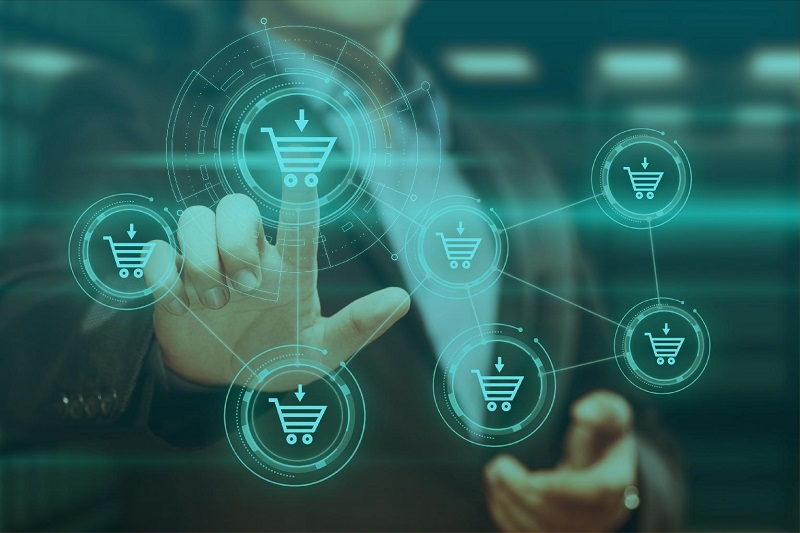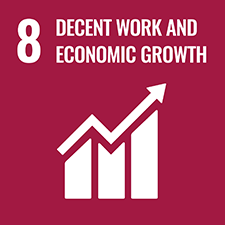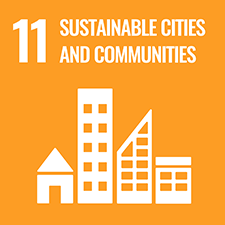
Online Retail Business Trend During Covid
14 Dec, 2021
Within articles series framework on spreading research and applied knowledge from UEH, Knowledge Newsletter DIGITAL ECONOMIC #1, we have commented on positive effects besides negative ones that Covid-19 pandemic has brought towards the accelerating process related to "digital economy" reconstruction as well as the changes in consumers’ shopping behaviors in Vietnam. How have businesses produced and distributed goods on their own digital platforms as well as E-commerce and retail platforms embarked towards this change to meet ‘Covid-19’ trend?

Picture regarding E-commerce in terms of this Covid-19 epidemic context
The fact that COVID-19 pandemic has made consumers stay at home more, with some areas restricted to travel and limited opening of shopping malls has resulted in the rapid and strong growth in online shopping. The data shows that Vietnamese E-commerce will achieve an impressive growth of 18% in 2020, the market size will reach 11.8 billion USD, accounting for 5.5% of total retail sales of goods and national consumption service revenue. With this impressive growth, Vietnam is considered to be quickly becoming the leading "appealing piece of cake" for E-commerce in Southeast Asia.
Dr. Nguyễn Ngọc Hòa - Chairman of Member Board of Ho Chi Minh City Financial Investment Company (HFIC), with many operation years in retail trade field, shared about the role of E-commerce in Covid-19 pandemic context:
Dr. Nguyễn Ngọc Hòa: The pandemic has caused widespread fear related to health, job security, life quality and financial stability at both individual and macro levels. This has directly affected people's income, spending has slowed down, consumer behavior has changed in both short and long terms.
- Consumers: Social distancing has restricted travel. The pandemic has accelerated digitization to a massive extent. Consumers demand a variety of choices and flexibility. They expect to make purchases on computers, phones or in stores. As a result, customers will prefer to switch to the entire online shopping cycle;
- Retailers: Convenience for customers is always the main program of all retailers. 70% of retailers have either introduced new digital channels or enhanced existing digital channels as a result of the pandemic;
- Manufacturers: Commodities & industries need to prepare to meet digital demands;
- Support of online payments: Before COVID period, online payments were an option, rather than a necessity. Currently, digital payments and contactless payments become the mainstream (Internet banking, E-wallets and so on). Consumers embrace convenience and prefer online payments across channels, for large and small purchases;
- Technology solutions: Being cheaper and faster thanks to potential partners’ proliferation who offer both software and supply chain as a service.
All have facilitated and promoted the strong development of E-commerce.
What is customers’ actual concern upon shopping online during the epidemic? Which E-commerce channels are being used a lot by Vietnamese users? Let's listen to the sharing of Dr. Đỗ Thị Hải Ninh - Lecturer at Faculty of International Business-Marketing, UEH Business School.
Dr. Đỗ Thị Hải Ninh: During my lecturing process, I actually did ask students in an E-business class that, from the customer's perspective, what their concerns were towards shopping online, a lot of ideas/opinions/answers were discussed in class: from very basic issues (where to buy, how to buy, whether or not to buy a product and so on) to more difficult problems (their interest in how E-commerce site operates, reputation or price).
Recently, in a class discussion about this question related to the epidemic environment, most answers leaned towards health issues. Indeed, in accordance with the latest Nielsen research, health is Vietnamese people’ biggest concern during this period. Therefore, all customer's buying and selling activities on online platforms are associated with a health story, whether for mental health or physical health.
Although Covid epidemic brings with it a lot of consequences, in terms of E-commerce industry itself, this is a springboard for E-commerce to gain momentum and take a big leap. Although consumers still have many concerns related to shipping costs, customer trust or delivery time and other arising problems (how to deliver and receive goods), they still ensure safety service in this pandemic context.
During this widespread epidemic time, retailers who have been prepared as well as technologically capable, have achieved incredible sales on their E-commerce platforms. Like Green Department Store (Bách Hóa Xanh) with a sales channel via Zalo or Saigon Co.op with both website channel and Zalo and apps, Aeon also has its apps to help with ordering. It is certain that available E-commerce platforms, other big players like Tiki, Shopee and Lazada are not out of the game towards fresh food, an item that, if going back 3 years ago, no big man would want to jump in retail on his platform.

Dr. Nguyễn Ngọc Hòa - Chairman of Member Board of Ho Chi Minh City Financial Investment Company (HFIC) (in the middle) and Dr. Đỗ Thị Hải Ninh - Lecturer of International Business-Marketing Faculty, UEH Business School (right) shared at ‘Life knowledge’ Program on HTV9
Within the background of rapidly evolving market forces, Businesses are adjusting themselves towards accepting the “new normal,” changing to survive, and sometimes, thrive, in this post-COVID era. Therefore, it is investment and development of online sales in parallel with offline sales as a requirement of the market and customers that retailers, in general, and supermarkets, in particular, must deploy if they target to survive and compete successfully on the market.
It can be recognized that buying and selling on online platforms used to be rather strange to the majority of consumers; nevertheless, in the past few years, that Vietnamese consumers have considered shopping on online platforms as a part of their life has been especially correct for young people, Generation Z, a generation born and raised with technology development around them. Therefore, shopping on online platforms has become very familiar, consumers do not wonder how to buy; rather, they wonder about the products themselves more.
Consumers have changed, they pay more attention to products with small values or those familiar. In accordance with statistics report by Ministry of Industry and Trade, in 2015, more than 10,000 items were traded on E-commerce platforms. Items like fashion pieces, daily necessities wth small value are traded quite actively on these platforms.
In particular, before the epidemic, food, including fresh food, was listed with limitation in consumers' shopping carts when choosing to buy online. Nevertheless, during the past pandemic, fresh food selection for life was the most-ordered item on E-commerce sites.
Challenges of online retail business in Covid period
As online sales becomes a larger revenue channel for brands and merchants, E-commerce platforms need to be adapted and coordinate with them to realize innovative retail strategies to attract more customers. With this development momentum, E-commerce businesses will receive opportunities and challenges as the platforms must constantly modify to meet customers’ needs.
In Dr. Nguyễn Ngọc Hòa’s viewpoint, which factors will affect the development of commercial business activities on Vietnamese retailers’ digital platform?
First, it is necessary to realize that the commerce business on the digital platform of today's retail businesses must be based on an integrated multi-channel platform – Omni-channel:
- Omni-channel refers to transaction across a variety of channels, which may include exchanges, social channels, physical stores and more. Omni-channel has become a popular terminology, but it's not just another way of saying you sell across multiple-channels.
- A truly integrated Omni-channel approach must deliver a consistent brand experience everywhere it sells in order to satisfy customers wherever they are and build superior relationships across channels
- It must also include the emphasis on optimizing the enterprises through channel diversification and comprehensive integration between enterprise data and systems.
Second, the requirements of integrated omnichannel retail – Omni-channel: conversion, integration and collaboration – must be clearly identified:
- The biggest challenge in Omni-channel – which has been exacerbated during the pandemic – is to get the supply chain to be on track;
- Stores are an integral part of the supply chain for shipping and handling customers’ returns. 80% of consumers who return products in-store will receive a in-store refund;
- Revenue is processed by integrating the physical stores in the whole process;
- Requiring a company-scope transformation that covers most functions: marketing, stores, sales, supply chain and IT and so on;
- The key here, involving store networking (the hardest challenge), is to figure out which types of Omni-channel work best for consumers and which are the most profitable.
Third, customers’ willingness: Instead of protecting every personal piece of data, customers, currently, are more willing to share sensitive information – COVID has helped customers build trust in data sharing. Consumers are more comfortable sharing data with vendors if they believe the data is used responsibly. This helps retailers know their customers on a whole new level and personalize offers and promotions better than before.
In addition to these impacts that will affect the retail business and commerce on Vietnamese retailers’ digital platform, the biggest problem is probably customers’ trust with online shopping activities. One survey in 2019 aiming at finding out customer satisfaction, more than 50% of the respondents were not satisfied with online shopping because the quality of the goods was not as advertised; therefore, causing customers to distrust the sales unit, many products are attached with pictures for illustrative purposes only: the received products are different, leading to the loss of consumers' trust. Consequently, Trust element has become the biggest obstacle for consumers to choose this sales channel.
In addition, the fear of personal information leak (being revealed to the outside) is also another concern, especially when the big players in E-commerce industry are all shaking hands with electronic payment applications (E-wallets). Worrying about banking account information reveal is also one of the biggest concerns for consumers.
It can be seen that current Vietnamese consumers do not find it difficult to use apps, applications or orders on websites, they are worried about product quality, personal information and shipping services that are major issues that consumers are worried about. Last but not least, maybe, it is the lack of a legal corridor to support and protect consumers on E-commerce platforms: which laws and sanctions are strong enough to handle small frauds on E-commerce platforms?
Lessons learned from countries around the world
Within the first 90 days of Covid pandemic, E-commerce industry has been experiencing 10-year digital application for consumers and businesses. Giant E-commerce companies (Amazon, Alibaba.com, eBay and so on), all of which have had skyrocketing sales. This means that their business strategy, supply chain, and operating model have completely met customers’ needs, creating opportunities for sales teams to approach new customers. Thousands of new technology partnerships have been formed to support and optimize efforts in E-commerce.
Why are big E-commerce companies in the world like Amazon, Alibaba and so on successful during the outbreak of the epidemic?
Dr. Đỗ Thị Hải Ninh shared: Maybe, using ‘ripe opportunity’ term or ‘natural time, favorable location and human harmony’ phrases for this case can explain the most reasonably.
The epidemic has created an opportunity and created momentum for E-commerce companies to develop; however, we should look at the fact that E-commerce companies have prepared themselves, from building a system of solutions ready to develop and turn over, big E-commerce enterprises like Amazon or Alibaba have had a time to build customers’ database, this is considered as a new source of knowledge, new knowledge for business innovation.
Second, when the epidemic broke out, many countries enforced blockade or social distancing orders, worldwide Internet traffic increased by up to 70%, most of which were used for services. Some countries have actually intervened to upgrade the Internet system so that it can run an entirely-or-partially digitized economy.
Banks are also joining an arm to help boost digital payments faster and easier. In China, the handshakes of big players like E-commerce floors with E-wallets and banks can be clearly seen.
Last but not least, the vast majority of users have been learning and developing their buying and selling skills on E-commerce platforms quickly.
It should be stated that there has never been a time when businesses, residents and the State have been sharing the same opinion towards promoting the economy digitization, of which E-commerce is only a part.
From the effects that businesses around the world are applying, can Dr. Nguyễn Ngọc Hòa share more effective e-retail business lessons in Vietnam?
- Meeting customers where they are: (1) COVID doesn't stop people from transacting – it just redirects and disperses that activity through different channels; (2) E-commerce becomes the mainstay, social channels take advantage of the audience in launching new commerce features and exchange floor access spikes; (3) Consumers discover brands and products in new ways – advertising on Facebook and Instagram, Google shopping, Amazon and other marketplaces, product reviews, in-store discovery, word of mouth and more; (4) Consumers can encounter your brand on desktop, television or mobile devices;
- Being outstanding in the crowded playground: (1) With more and more retailers are competing for online attention, being standing-out requires a more resounding brand, a better shopping experience with great service; (2) Retailers must adapt to customers’ new needs and behaviors, re-adjust their target customers’ understanding; (3) Use data to understand & rethink about: products, sales channels, advertising channels, messaging;
- Optimizing with data and analysis: (1) Understanding data will help retailers determine where and how to focus their energy. (2) Comprehensive, integrated multi-channel allowing centralizing data from all sources and channels to determine the best way to balance inventory, satisfy customers anywhere, and deliver great service no matter where they shop.
Appropriate solutions for online retail businesses
In accordance with previous studies, the biggest difference in 2020, in terms of production and business activities, compared to 2018 and 2019, is in the sales channel. The trend that houses are as markets, offices, schools and so on ensures measures to prevent COVID-19 epidemic, E-commerce and online channels are an indispensable part. This leads to the transformation of the traditional retail model into offline and online Omni-channel retail, as well as Omni-channel retail model as follows: goods are sold wherever customers are.
Multi-channel sales model
From Dr. Đỗ Thị Hải Ninh’s personal viewpoint, what are the advantages of Omni-channel sales model as well as the notes upon implementing this business model?
2021 is a year when many retailers have realized their current development trend is to have a strong transition to multi-channel sales, promoting sales on online platforms besides optimizing traditional sales channels. In 2020, many retailers had revenue growth compared to that of 2019 thanks to the rapid transition into an Omni-channel sales model for market fluctuation adaption. The advantages of Omni-channel sales model are diverse; however, the first thing to mention is that its ability in increasing interaction and perfecting the users’ experiences is a great advantage of multi-channel sales channel: when users are also using multi-channels, they appear at many different touch-points, on many different channels; if businesses do not understand these customers’ journey, the loss of customers to competitors is an overnight consequence. The second advantage is to help businesses be more flexible in the way they operate their business. It can be clearly seen that, during the epidemic, traditional businesses cannot withstand this wave; nevertheless, businesses that quickly take advantage of multi-channels can not only operate but also grow in revenue.
Please be noted that upon using multi-channel, it is certain that businesses cannot assure that the maximum channel is to be multi-channel tomorrow, they need to build a specific strategy, with a development roadmap; especially, they need to understand customers, when big data on customer behavior is being collected by retailers, they believe that they have realized that the omni-channel path, despite being brilliant, is still rough and hard underfoot. Which channel one enterprise opens, when to open it, how to operate that channel and how to link the channels together to bring a complete experience to new customers is the goal of multi-channel. It is due to the fact that the channel is just a tool, the main thing is to be aiming towards customers’ satisfaction, and upon selling multi-channel, businesses also need to look at their business activities to identify whether if they have taken customers as their focus or not.
In addition, Dr. Đỗ Thị Hải Ninh also shared further details regarding how to proactively capture consumers’ insights and behaviors, thereby, introducing attractive promotions and optimizing sales on digital platforms.
Talking about military methods in this context, maybe, is rather abnormal; however, it is precise that to know competitors, to know yourself means to win a hundred battles. Businesses would like to get into customers’ minds, to sell goods and optimize sales, it is crucial for them to understand customers, please do understand consumers first. Once understanding, they will know how they absolutely need a product, when they want it, where they want it and how they want it. Businesses can apply multi-channel experiences to complete customers’ journey, to give customers a great experience; or businesses can personalize and customize products with distinctive messages for each customer’s journey.
Currently, a variety of different ways to collect and capture customers’ insights are available, thanks to information technology development, Big Data and AI should be considered by businesses to apply in analysis processes and understanding users. No matter how attractive flash sales, golden hour discounts or promotions are, the results are being ineffective without understanding and solving users’ problems. The point here is to completely understand the users first of all.
Developing E-commerce into a sustainable ecosystem
Successful implementation of integrated omni-channel retail – Omni-channel needs to be dependent upon the following 4 main pillars:
- Sales channels:
(1) Many sales channel options are available so the retailers must carefully evaluate the customers: where they spend their most time and where the products in the category are usually sold;
(2) Channels: Online Store Interface, E-Commerce Exchange, Social Media Platform, Mobile Channel, Physical Store – or any place using POS, B2B/Wholesale and so on.
- Marketing and advertising:
(1) Even the best products and best websites need an integrated omni-channel marketing strategy to drive access and sales;
(2) Delivering the right message at the right time and in the right place, all of which are tied together by a consistent brand experience, is able to make a big difference to a retailer's bottom line;
(3) Channels: Shopping Ads, Google, Exchange Floor Advertisements, Social Media, Email and SMS.
– Operation & Functioning:
(1) The key to a multi-channel approach that integrates functions is to connect everything: product management, orders, inventory, logistics and fulfillment;
(2) Inventory visibility is the biggest barrier for an inventory manager in omni-channel business so as to optimize the supply chain and not to miss a beat among sales platforms.
– Transport and implementation:
(1) The retailer has the option of using shipping software or a 3PL company (Third-party logistics);
(2) Logistics and fulfillment are the E-commerce technical aspects; actually, it is another extension of the customer experience.
What is more, to be ready for a sustainable ecosystem, it is necessary to consider 3 aspects as follows: businesses, infrastructure and consumers. In which, has the enterprise prepared its resources, goals and business model?
The resources mentioned here refer to human resources and capital resources: employees have been trained and aware of the importance of E-commerce. Not many businesses have totally considered E-commerce properly, only considering it as an extension arm, only temporary without any serious investment in development. This is the weakest point in digital transformation activities of businesses. In terms of business model, the current situation of Vietnamese market is currently divided into 3 types: 1st as authentic - only executing direct business; 2nd type with combining and considering E-commerce as an auxiliary part; 3rd type as pure E-commerce businesses. This number is being limited in the market, the 2nd type is being on the rise and likely to become the industry leader in the next few years.
The second aspect is the infrastructure, from hardware to software. The hardware we need to have is Internet system, wifi, network system and data delivery platforms, all of which Vietnam needs to upgrade quite intensively in the near future. Software is a legal corridor, consultation of state agencies (Department of Industry and Trade, Department of Information and Communication or beyond from relevant Ministries) in order to create a consistent and supportive mechanism for enterprises implementing E-commerce activities.
Last but not least, after this pandemic, all consumers definitely have undergone an advanced training course on E-commerce; therefore, this section can confidently state that there has been preparation, unlike the context of two years ago, consumers did not consider E-commerce as an official formal commercial activity.
Please refer to the full paper of ‘Digital-platform-based commercial business of Vietnamese retail enterprises before and during Covid-19 epidemic’ research by author group here. Author group is comprised of: Assoc. Pro. Dr. Bùi Thanh Tráng, MSc. Hoàng Thu Hằng, Dr. Đỗ Thị Hải Ninh, MSc. Dương Ngọc Hồng, MSc. Hoàng Ngọc Như Ý (Department of International Business - Marketing, UEH School of Management).
This writing is in Series Research and applied knowledge from UEH, we would like to invite distinguished readers to look forward to Knowledge News ECONOMY NO. #20 “Lifelong study at UEH: Being towards a sustainable University”.
News and photos: Author group, UEH Department of Marketing and Communication.
This news is edited from Life knowledge Program – Science and Educational Department – Ho Chi Minh City Television (HTV9)




![[Research Contribution] Climate Adaptation and Ownership Structure: Determinants of Global Bank Performance](/images/upload/thumbnail/ueh-thumbnail-639024479352054880.png)



![[Research Contribution] Wage or Survival Fee? A New Perspective on Provincial Minimum Living Wages in Vietnam](/images/upload/thumbnail/ueh-thumbnail-639024468410266657.png)

![[Research Contribution] A Model for Assessing the Impact of Accounting Data Analytics on Sustainable Information Presentation in the Public Sector](/images/upload/thumbnail/ueh-thumbnail-639024469396621767.png)

![[Research Contribution] A Strategy for Engaging Stakeholders to Implement Living Labs for Addressing Urban Issues](/images/upload/thumbnail/ueh-thumbnail-639024459455096821.png)